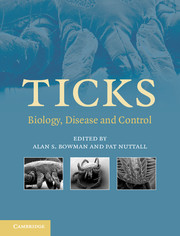Book contents
- Frontmatter
- Contents
- List of contributors
- Preface
- 1 Systematics and evolution of ticks with a list of valid genus and species names
- 2 The impact of tick ecology on pathogen transmission dynamics
- 3 Tick salivary glands: the physiology of tick water balance and their role in pathogen trafficking and transmission
- 4 Tick saliva: from pharmacology and biochemistry to transcriptome analysis and functional genomics
- 5 Tick toxins: perspectives on paralysis and other forms of toxicoses caused by ticks
- 6 Tick lectins and fibrinogen-related proteins
- 7 Endocrinology of tick development and reproduction
- 8 Factors that determine sperm precedence in ticks, spiders and insects: a comparative study
- 9 Tick immunobiology
- 10 Saliva-assisted transmission of tick-borne pathogens
- 11 Lyme borreliosis in Europe and North America
- 12 Viruses transmitted by ticks
- 13 Babesiosis of cattle
- 14 Theileria: life cycle stages associated with the ixodid tick vector
- 15 Characterization of the tick–pathogen–host interface of the tick-borne rickettsia Anaplasma marginale
- 16 Emerging and emergent tick-borne infections
- 17 Analysing and predicting the occurrence of ticks and tick-borne diseases using GIS
- 18 Acaricides for controlling ticks on cattle and the problem of acaricide resistance
- 19 Anti-tick vaccines
- 20 Anti-tick biological control agents: assessment and future perspectives
- 21 Pheromones and other semiochemicals of ticks and their use in tick control
- Index
- References
12 - Viruses transmitted by ticks
Published online by Cambridge University Press: 21 August 2009
- Frontmatter
- Contents
- List of contributors
- Preface
- 1 Systematics and evolution of ticks with a list of valid genus and species names
- 2 The impact of tick ecology on pathogen transmission dynamics
- 3 Tick salivary glands: the physiology of tick water balance and their role in pathogen trafficking and transmission
- 4 Tick saliva: from pharmacology and biochemistry to transcriptome analysis and functional genomics
- 5 Tick toxins: perspectives on paralysis and other forms of toxicoses caused by ticks
- 6 Tick lectins and fibrinogen-related proteins
- 7 Endocrinology of tick development and reproduction
- 8 Factors that determine sperm precedence in ticks, spiders and insects: a comparative study
- 9 Tick immunobiology
- 10 Saliva-assisted transmission of tick-borne pathogens
- 11 Lyme borreliosis in Europe and North America
- 12 Viruses transmitted by ticks
- 13 Babesiosis of cattle
- 14 Theileria: life cycle stages associated with the ixodid tick vector
- 15 Characterization of the tick–pathogen–host interface of the tick-borne rickettsia Anaplasma marginale
- 16 Emerging and emergent tick-borne infections
- 17 Analysing and predicting the occurrence of ticks and tick-borne diseases using GIS
- 18 Acaricides for controlling ticks on cattle and the problem of acaricide resistance
- 19 Anti-tick vaccines
- 20 Anti-tick biological control agents: assessment and future perspectives
- 21 Pheromones and other semiochemicals of ticks and their use in tick control
- Index
- References
Summary
INTRODUCTION
Ticks transmit a wide variety of arboviruses (arthropod-borne viruses). Tick-borne viruses are found in six different viral families (Asfarviridae, Reoviridae, Rhabdoviridae, Orthomyxoviridae, Bunyaviridae, Flaviviridae) and at least nine genera. Some as yet unassigned tick-borne viruses may belong to a seventh family, the Arenaviridae. With only one exception (African swine fever virus) all tick-borne viruses (as well as all other arboviruses) are RNA viruses. Some tick-borne viruses pose a significant threat to the health of humans (tick-borne encephalitis virus, Crimean–Congo haemorrhagic fever virus) or livestock (African swine fever virus, Nairobi sheep disease virus). This chapter first considers the characteristics of ticks important in virus transmission and then presents an overview of the tick-borne members of different virus families.
TICKS AS VECTORS OF ARBOVIRUSES
Ticks are not insects. The significance of this statement is considered in a review of the marked contrasts between the biology of ticks and that of insects, and the consequences for their potential to transmit micro-organisms (Randolph, 1998). Interestingly, tick-borne viruses are found in all the RNA virus families in which insect-borne members are found, with the exception of the family Togaviridae. Virus–tick–vertebrate host relationships are highly specific, and fewer than 10% of all tick species (Argasidae and Ixodidae) are known to play a role as vectors of arboviruses. However, a few tick species transmit several (e.g. Ixodes ricinus, Amblyomma variegatum) or many (I. uriae) tick-borne viruses.
- Type
- Chapter
- Information
- TicksBiology, Disease and Control, pp. 253 - 280Publisher: Cambridge University PressPrint publication year: 2008
References
- 13
- Cited by

